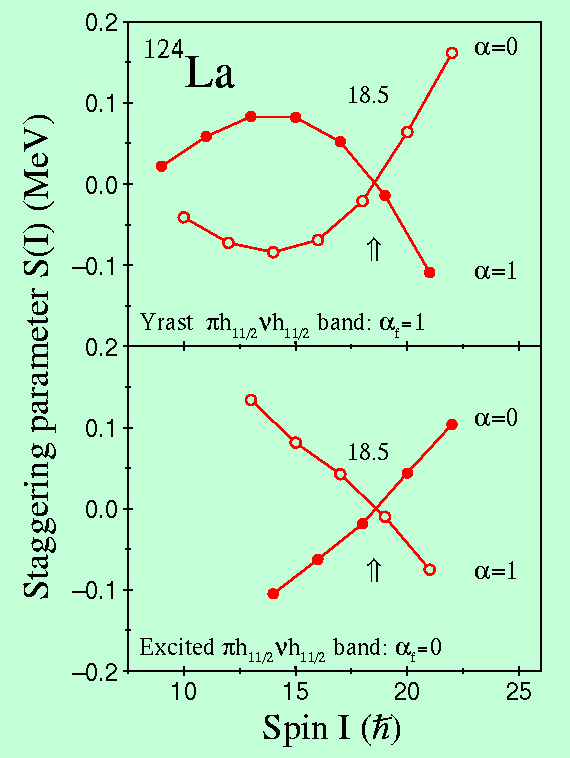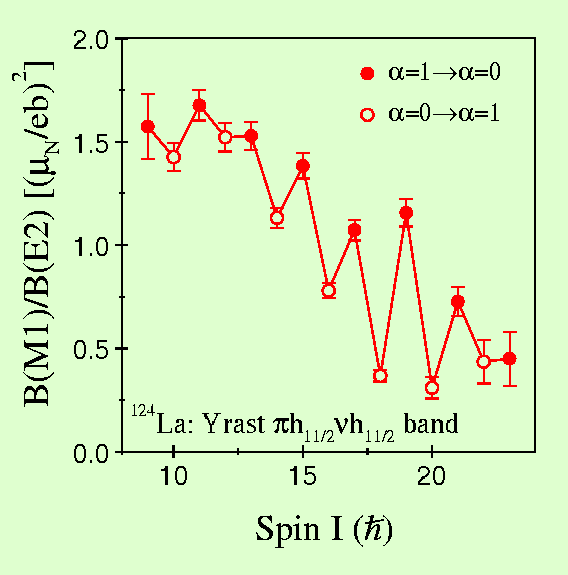In ![]() I=1 bands of doubly odd nuclei,
the two signatures,
i.e. the odd-spin and even-spin members, are usually not equivalent
energetically. Due to the Coriolis force acting on the valence
particles, one signature, called favoured is lower in energy
that the other signature. For a single particle in a j shell, the
favoured signature is given by the simple rule:
I=1 bands of doubly odd nuclei,
the two signatures,
i.e. the odd-spin and even-spin members, are usually not equivalent
energetically. Due to the Coriolis force acting on the valence
particles, one signature, called favoured is lower in energy
that the other signature. For a single particle in a j shell, the
favoured signature is given by the simple rule:
![]() f=j mod 2.
Hence for a doubly odd nucleus:
f=j mod 2.
Hence for a doubly odd nucleus:
![]() f
= [ jp + jn ] mod 2, which can be
either 0 (even-spin levels) or 1 (odd-spin levels), depending on
the configuration.
f
= [ jp + jn ] mod 2, which can be
either 0 (even-spin levels) or 1 (odd-spin levels), depending on
the configuration.
Doubly odd nuclei of the mass A~125 light rare-earth region exhibit
the phenomenon of signature inversion whereby the
unfavoured signature component
![]() u
of certain bands actually lies lower in energy than the
corresponding favoured
u
of certain bands actually lies lower in energy than the
corresponding favoured
![]() f
component at low spin. Specifically, for the
f
component at low spin. Specifically, for the
![]() h11/2
h11/2 ![]() h11/2 configuration
the favoured
h11/2 configuration
the favoured ![]() =1
signature, defining odd-spin levels,
only becomes yrast (i.e. energetically
favoured) at spin I~18
=1
signature, defining odd-spin levels,
only becomes yrast (i.e. energetically
favoured) at spin I~18![]() relative
to the
relative
to the ![]() =0 signature, defining
even-spin levels.
The systematics of the critical
inversion spin have been the subject of several recent studies and
this phenomenon is still not fully understood theoretically. Triaxiality,
strong neutron-proton interactions, and quadrupole pairing have been
invoked to explain signature inversion.
In 124La [Ref]
twin
=0 signature, defining
even-spin levels.
The systematics of the critical
inversion spin have been the subject of several recent studies and
this phenomenon is still not fully understood theoretically. Triaxiality,
strong neutron-proton interactions, and quadrupole pairing have been
invoked to explain signature inversion.
In 124La [Ref]
twin ![]() h11/2
h11/2 ![]() h11/2 bands have been identified
in a GAMMASPHERE plus
MICROBALL
plus
NEUTRON SHELL
experiment (GSFMA79). The yrast band shows signature inversion in its
level energies below
I=18.5
h11/2 bands have been identified
in a GAMMASPHERE plus
MICROBALL
plus
NEUTRON SHELL
experiment (GSFMA79). The yrast band shows signature inversion in its
level energies below
I=18.5![]() , while the excited band shows
signature inversion above I=18.5
, while the excited band shows
signature inversion above I=18.5![]() ,
as shown in the following diagram. The expected favoured signatures are
denoted by the solid symbols.
,
as shown in the following diagram. The expected favoured signatures are
denoted by the solid symbols.

A signature dependence of the B(M1)/B(E2) ratios is also observed
in the yrast ![]() h11/2
h11/2
![]() h11/2 configuration of
124La, as shown in the following figure.
In this case, the ratios are larger for transitions
from the `favoured' signature to the `unfavoured' signature, but
unlike the level energies, show no inversion (change of phase). The
staggering, however, reaches a maximum around
I=18.5
h11/2 configuration of
124La, as shown in the following figure.
In this case, the ratios are larger for transitions
from the `favoured' signature to the `unfavoured' signature, but
unlike the level energies, show no inversion (change of phase). The
staggering, however, reaches a maximum around
I=18.5![]() - the inversion spin of the
level energies!
The staggering arises solely from
Coriolis effects of the B(M1) reduced transition probabilities.
B(E2) values are not expected to
show any signature dependence and behave smoothly with spin.
- the inversion spin of the
level energies!
The staggering arises solely from
Coriolis effects of the B(M1) reduced transition probabilities.
B(E2) values are not expected to
show any signature dependence and behave smoothly with spin.

Signature inversion has systematically been observed in doubly odd nuclei
of other mass regions. These include ![]() g9/2
g9/2 ![]() g9/2
bands of mass 80 nuclei,
g9/2
bands of mass 80 nuclei,
![]() h11/2
h11/2 ![]() i13/2 bands of mass 160 nuclei,
and recently
i13/2 bands of mass 160 nuclei,
and recently ![]() g9/2
g9/2 ![]() h11/2 bands of mass 100 nuclei
[Ref].
h11/2 bands of mass 100 nuclei
[Ref].
Document Last Modified
Maintained by Eddie Paul <esp@ns.ph.liv.ac.uk>